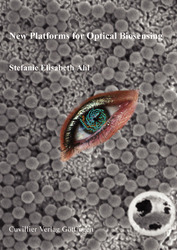| Areas | |
|---|---|
| Serie de libros (96) |
1378
|
| Nachhaltigkeit |
3
|
| Gesundheitswesen |
1
|
| Letra |
2363
|
| Ciencias Naturales |
5406
|
| Matemática | 229 |
| Informática | 319 |
| Física | 980 |
| Química | 1363 |
| Geociencias | 131 |
| Medicina humana | 243 |
| Estomatología | 10 |
| Veterinaria | 108 |
| Farmacia | 147 |
| Biología | 835 |
| Bioquímica, biología molecular, tecnología genética | 121 |
| Biofísica | 25 |
| Nutrición | 45 |
| Agricultura | 1004 |
| Silvicultura | 201 |
| Horticultura | 20 |
| Ecología y conservación de la tierra | 148 |
| Ciencias Ingeniería |
1791
|
| General |
97
|
|
Leitlinien Unfallchirurgie
5. Auflage bestellen |
|
Erweiterte Suche
Optical Biosensors in a New Design (Tienda española)
Stefanie Ahl (Autor)Previo
Indice, Datei (17 KB)
Lectura de prueba, Datei (100 KB)
Physicochemical experimental techniques combined with the specificity of a biological recognition system have resulted in a variety of new analytical devices known as biosensors. Biosensors are under intensive development worldwide because they have many potential applications, e.g. in the fields of clinical diagnostics, food analysis, and environmental monitoring. Much effort is spent on the development of highly sensitive sensor platforms to study interactions on the molecular scale.
In the first part, this thesis focuses on exploiting the biosensing application of nanoporous gold (NPG) membranes. NPG with randomly distributed nanopores (pore sizes less than 50 nm) will be discussed here. The NPG membrane shows unique plasmonic features, i.e. it supports both propagating and localized surface plasmon resonance modes (p SPR and l-SPR, respectively), both offering sensitive probing of the local refractive index variation on/in NPG. Surface refractive index sensors have an inherent advantage over fluorescence optical biosensors that require a chromophoric group or other luminescence label to transduce the binding event.
In the second part, gold/silica composite inverse opals with macroporous structures were investigated with bio- or chemical sensing applications in mind. These samples combined the advantages of a larger available gold surface area with a regular and highly ordered grating structure. The signal of the plasmon was less noisy in these ordered substrate structures compared to the random pore structures of the NPG samples.
In the third part of the thesis, surface plasmon resonance (SPR) spectroscopy was applied to probe the protein-protein interaction of the calcium binding protein centrin with the heterotrimeric G-protein transducin on a newly designed sensor platform. SPR spectroscopy was intended to elucidate how the binding of centrin to transducin is regulated towards understanding centrin functions in photoreceptor cells.
| ISBN-10 (Impresion) | 3867273405 |
| ISBN-13 (Impresion) | 9783867273404 |
| Formato | A5 |
| Idioma | Inglés |
| Numero de paginas | 180 |
| Edicion | 1 |
| Volumen | 0 |
| Lugar de publicacion | Göttingen |
| Lugar de la disertacion | Mainz |
| Fecha de publicacion | 21.08.2007 |
| Clasificacion simple | Tesis doctoral |
| Area |
Biología
|
| Palabras claves | Propagierende und lokalisierte Oberflächen-Plasmonen-Resonanz (p-/l-SPR); Schichtaufbau; Inverse Opale; Centrin; Transducin; Photorezeptor. |








